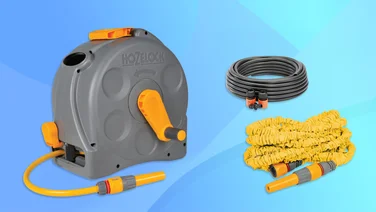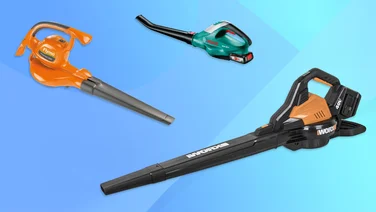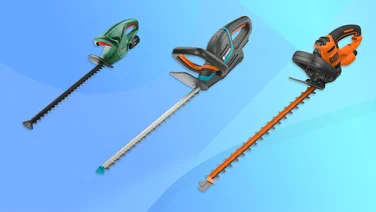To help us provide you with free impartial advice, we may earn a commission if you buy through links on our site. Learn more
- How to choose the best chainsaw for you
- The best chainsaws you can buy in 2023
- 1. Makita UC3541A: A superb chainsaw whose performance belies its low price
- 2. Black & Decker GKC3630L20: A premium cordless chainsaw with a long-lasting battery
- 3. Ryobi OCS1830: This cordless cutter is excellent value – if you already own a compatible battery
- 4. DeWalt DCM575: A fantastic cordless chainsaw that’s both powerful and versatile
- How we test

Trees are a great feature in any garden, but they have a habit of growing way too large – and getting out of control. If you’ve got one like this, or you need to chop a winter’s worth of firewood, then congratulations: you’ve got a great excuse to buy a chainsaw. You might think such tools are petrol-powered beasts meant only for professionals, but thanks to advances in brushless motor technology, a compact electric chainsaw can be yours for far less than you might imagine.
Whether you’re looking to make short work of pruning, or have a few trees you’d like to get rid of, we’ve got you covered with everything you need to know to get the job done – and our recommendations to help you pick the right tool for the job.
How to choose the best chainsaw for you
What type of chainsaw should I buy?
For home use, we’d recommend you pick an electric chainsaw, rather than one with a heavyweight petrol engine. These aren’t as powerful, but for amateurs that’s not a bad thing. It means they’re far lighter than petrol models and easier to wield precisely. That, in turn, means they’re also safer – and you don’t need to keep petrol cans around the house. Lower-powered chainsaws are more neighbour-friendly as they’re quieter when cutting and don’t make any noise at all when idling.
SEE NEXT: The best multi-tool you can buy
Should I buy a battery or mains-powered chainsaw?
In most cases a battery-powered chainsaw won’t be as powerful as a mains-powered saw; if you have a larger tree to fell, you’ll find a corded model the way to go, as they can run for longer. With high-powered battery technology also being expensive, a mains-powered chainsaw will normally offer better bang-per-buck.
However, a cordless design offers you much more freedom to roam around, which is great if you’re pruning bushes all over the garden. If you really need both freedom and power, check out the DeWalt DCM575, reviewed below, which offers more power than many mains-driven models, albeit at a price.
How do I keep a chainsaw running smoothly?
It’s important to keep the chain on your saw properly tensioned: this will help it last longer and cut better and, crucially, it’s safer, too. The tension is likely to wobble in the first few hours after you install a new chain, so it’s a big plus if you can adjust it without needing tools. A tool-free design also means that if you need to release the chain or bar, perhaps because a branch or trunk has pinched the saw and trapped it, you can do so without having to hunt around for the right tool, and more quickly get back to the task at hand.
What do manufacturers mean when they talk about ‘bar length’?
The bar – the bit the cutting chain runs around – is a major differentiating factor among chainsaws. A longer bar lets you cut more wood in one go, but it also makes the saw heavier and a bit harder to wield. If all you want to do is pruning, it makes sense to go for a smaller-barred, easier-to-handle model.
What kind of safety features should I look out for?
A chain brake instantly stops the saw if the finger-guard at the front of the chainsaw gets pushed forwards, and it’s an effective safety feature should the saw experience kickback. Not all electric chainsaws have this feature, and it may not be a deal-breaker, depending on the sort of job you’re planning to take on. It’s something to consider, though: if there’s a chance you might end up using your chainsaw to tackle a big gnarly tree, it’s definitely a case of better being safe than sorry.
The best chainsaws you can buy in 2023
1. Makita UC3541A: A superb chainsaw whose performance belies its low price

Price: £133 | Buy now from ToolstationWhile not as cheap as the Titan, the Makita feels like a much more professional tool than its price tag would suggest. Virtually vibration-free and exceptionally powerful, this well-built, 35cm-bar chainsaw comfortably devoured every challenge we set it.
Setup and chain tensioning is tool-free and fiddle-free, with big chunky adjusters and screws that can be easily operated while wearing gloves. We also appreciated the Makita’s large 200ml oil tank, which means you don’t need to carry a bottle of oil around with you. It’s also the only chainsaw in this roundup to have a removable, replaceable set of spike bumpers – the teeth that bite into wood close to the chainsaw body – a pro touch that frequent users will appreciate.
The 10-metre flex is another plus, allowing you loads of freedom to move around without dragging an extension cable around behind you. Our only complaint is that the black flex can be difficult to spot – the Titan’s bright orange number is a lot harder to lose.
In all, it’s a powerful, easy-to-use, comfortable saw that feels exceptionally well-built. For the occasional Paul Bunyan it’s worth every penny.
Key specs – Power source: Mains-powered with 10m flex; Bar length: 35cm; Chain speed: 14.5m/s; Chain brake: Yes; Oil tank capacity: 200ml; Spike bumper construction: Metal; Vibration: 4.7m/s2; Sound power: 101.3dBa; Weight: 4.7kg
2. Black & Decker GKC3630L20: A premium cordless chainsaw with a long-lasting battery
Price: £196 | Buy now from Amazon

The battery-powered GKC3630L20 is an exceptionally handy, 30cm-bar chainsaw that made light work of the various jobs we set it. The tool-free tensioning is a little fiddly, but it’s still preferable to messing around with a screwdriver – and once we’d set the saw up it was keen and powerful. Its chain speed of 5m/s is the slowest here, but by the standards of battery-operated saws it’s respectable enough.
What’s really great about the Black & Decker is how comfortable it is to use. We had no problem cutting through larger pieces of wood – although we had to exercise a little more patience than with corded saws, as the GKC3630L20’s lesser power began to tell on trickier, knottier lengths of wood. It’s long-lasting, though: the battery pack claims to be capable of 560 3.5cm cuts on one charge, and we certainly didn’t manage to exhaust it during a long period of repeated cutting.
We must mention that we noticed the Black & Decker leaking a little oil while it was sitting idle, which isn’t ideal, and there’s no chain brake. If that bothers you, compare the Ryobi OCS1830 (reviewed below) which costs about the same – once you’ve factored in the price of the battery – and features a chain brake and a larger oil tank.
It may have the slowest chain on test and a short blade, but this battery-powered saw can still make short work of any lighter jobs around the garden. Lightweight and easy to transport, the battery can hold its charge for up to 18 months when you’re not using it and comes with the battery in the box.
Key specs – Power source: 2.0Ah lithium-ion battery; Bar length: 30cm; Chain speed: 5m/s; Chain brake: No; Oil tank capacity: 110ml; Spike bumper construction: Plastic; Vibration: 5.5m/s2; Sound power: 92.8dBa; Weight: 5kg with battery
3. Ryobi OCS1830: This cordless cutter is excellent value – if you already own a compatible battery
Price: £174 with battery and charger | Buy now from Amazon

Ryobi’s chainsaw looks cheap at £119, but that price doesn’t include a battery. If you’re invested in Ryobi’s ONE+ range of tools (which includes everything from masonry drills to circular saws and palm sanders) then that’s no problem as you’ll already own a suitable battery and charger. Otherwise you’ll need to buy those alongside the saw itself. Options range from the lightweight 1.5Ah number to the chunkier 5.0Ah unit we tested with, which brings the total price up to nearly £174.
The saw itself is very pleasant in use. We were struck by its low vibration levels and comfortable grip, and it’s relatively lightweight too. Exactly how heavy it is depends on the battery you choose, but even with the largest compatible battery we found it easily wieldable.
Although the OCS1830 has twice the unloaded chain speed of the Black & Decker GKC3630L20, this didn’t seem to make much difference to its cutting ability. Smaller branches were dispatched with ease, while larger logs took a little longer, with the occasional stall during particularly difficult bits.
If you already own a Ryobi battery, the OCS1830 is a smartly economical route to cordless chainsaw ownership. Even if you don’t, it’s an affordable, high-quality tool that easily competes with the Black & Decker GKC3630L20.
Key specs – Power source: 5.0Ah lithium-ion battery; Bar length: 30cm; Chain speed: 10m/s; Chain brake: Y; Oil tank capacity: 200ml; Spike bumper construction: Plastic; Vibration: 6.6 m/s²; Sound power: 94.1dba; Weight: 3.74kg
4. DeWalt DCM575: A fantastic cordless chainsaw that’s both powerful and versatile
Price: £560 with battery and charger | Buy now from Amazon

The DCM575 is an awesome chainsaw: although cordless, it doesn’t compromise on power at all. Indeed, its 15m/s chain speed is the fastest here, and in terms of vibration and cutting efficiency we genuinely couldn’t tell the difference between it and a mains-powered saw.
The secret is a high-efficiency brushless motor, coupled with a giant 9Ah XR Flexvolt battery. This purports to provide up to 65 6x6in cuts per charge, and in our testing we certainly ran out of tree before we ran out of power. Once exhausted, it recharges in about 75 minutes, thanks to its actively cooled fast charger. The chunky battery makes the DCM575 the heaviest chainsaw on test, but the extra weight isn’t too noticeable. And since it’s part of DeWalt’s Flexvolt system, you can share the battery with other compatible tools, ranging from a grass cutter to a leaf blower and even a mitre saw.
Chain tensioning and bar and chain removal are tool-free (as you’d hope for this price), although if we were picking nits we’d have to say the plastic moulded spike bumper feels slightly cheap; we’d have been happier to see a removable metal one.
At a shade under £600, you’ll need to think carefully about the DCM575 – you could easily pick up a petrol chainsaw for this price that would offer more power and greater portability, while also having a larger bar. Similarly, if you’re an occasional tree surgeon who tackles the odd bit of firewood then this saw is likely to be overkill. Having said that, if you have a wood burner to feed, or simply want the most powerful electrical saw – including many cable-powered options – then this is a superb, if costly, option.
Key specs – Power source: 9.0Ah Lithium-ion battery; Bar length: 40cm; Chain speed: 15m/s; Chain brake: Y; Oil tank capacity: 115ml; Spike bumper construction: Plastic; Vibration: 3.5m/s2; Sound power: 100.5dBa; Weight: 5.4kg with battery
How we test
None of these saws are going to be used to fell a giant redwood, so we kept our testing comparatively domestic. For each model we practiced fitting, removing and correctly tensioning the chain, noting whether the process was particularly fiddly or required the use of Allen keys or similar to remove the chainguard. Obviously, there were bonus points for those saws that don’t send you running for a toolbox on noticing a bit of slack in the chain. We also evaluated the ease with which each saw could be filled with chain oil, while leaving each saw filled with oil on a shelf for a few days enabled us to spot any leaks.
Next, we cut down a ton or so of tree trunks into firewood-length pieces prior to splitting and drying them. No two pieces of wood are the same, but across the range of trunks there was a good mix of straight and knotty wood, and with each saw we performed “straightforward” cuts as well as a few trickier ones to gauge the level of power each model was able to put into a length of wood with pronounced knots. We made a series of cuts into logs ranging from 10cm to around 40cm in diameter, and applied minimal pressure to each saw while it was working, allowing gravity and the weight of the saw to provide cutting impetus along with the motor and chain of the saw itself.
For mains-powered saws we took into account the length of cable provided, bearing in mind that problematic trees are rarely situated next to handy three-pin electrical sockets, and also how easy each cable was to spot. Quite apart from the risk of accidentally cutting through your saw’s power source, anything that creates a trip hazard while you’re trying to put distance between yourself and a falling tree is a major problem.
While there will be no such trip hazards with battery-powered saws, they present their own challenges. Manufacturers of such saws often quote “cuts per charge” when making claims about a saw’s longevity in the field – but with manufacturers unable to agree on how thick a standard piece of wood is, these claims are all but meaningless. Instead, we ran each saw from an indicated full charge to exhaustion, covering tasks such as trimming twigs to cuts of just under a foot in total diameter. In particular, we noted if a saw’s battery was prone to fading, where it becomes progressively less powerful as the battery drains; or if it was able to maintain full power until the battery was completely empty. Of course, higher scores were awarded to saws that delivered full power for the maximum time.






